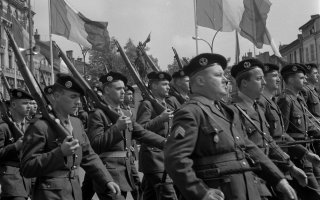France’s MAS 36 Bolt Action Rifle Served in World War II and Beyond
The rifle saw action in far-flung conflicts, from the First Indochina War to the Algerian War.
The MAS 36 was used throughout World War II by the Vichy French and Free French forces, and as such likely may have been one of the rare cases where both sides utilized the same rifle in combat during the war. However, due to budget constraints—again the French had that Maginot Line to pay for—MAS 36 production had been limited, so that at the outbreak of war many colonial units and even some units in France were still equipped with the Lebel rifles. The MAS 36 was often reserved for front line troops, where many were captured by the Germans.
It was put into service with garrison troops and later used by the German Volksstrum (People’s Army) at the close of the war. It was named the Gewehr 242 by the Germans.
The MAS 36 remained in production after the war until at least 1951, and was used throughout the French colonies, and as noted it was used as a training rifle until the late 1970s. It was replaced by the semi-automatic MAS 49 and MAS 49/56 rifles.
While the basic MAS 36 was the most common version, the French military had designed a notable variation in the form of the MAS 36 CR 39, which was designed specifically with paratroopers in mind. It differed most from the original version in that it featured an aluminum buttstock, which could be folded down and under the forend of the rifle.
In addition, beginning in 1951 the MAS 36 was converted to the MAS 36/51, which added a permanently attached grenade launcher and rifle grenade sights. The launcher was attached to the muzzle of the gun, while folding grenade sights were attached to the left side of the front sight base. It launched rifle grenades by utilizing special blank ammunition.
A marksman designated model was designed and used at the time of the Suez Crisis in 1957. This model, the FR-G2, featured a telescopic sight and a match grade barrel with a harmonic compensator. This model was reportedly produced in extremely limited numbers.
As the rifle was removed from service in 1978 some models were imported into the United States, but converted to 7.62x51mm NATO from 7.5x54mm. These rifles also feature an SKS type trigger safety fitted to them, likely to make these more attractive to the sport shooting crowd.
Finally, the MAS 36 also served as the basic platform for the FR F-1 and later FR F-2 sniper rifles, the latter of which is still in service with the French Armed Forces. The former, the FR F-1, actually utilized the same bolt design as the original MAS 36. It is a fine looking gun that probably in some ways was ahead of its time—and sadly in other ways is an example of why the French Army was utterly defeated so badly and so quickly in June of 1940.
Specifications:
Caliber: 7.5x54 mm
Overall length: 40.2 inches
Barrel length: 22.6 inches
Weight: 8.2 pounds empty
Stock: Wood
Sights: Hooded post front, aperture rear
Action: Bolt action
Finish: Blued
Magazine capacity: 5 rounds
Peter Suciu is a Michigan-based writer who has contributed to more than four dozen magazines, newspapers and websites. He is the author of several books on military headgear including A Gallery of Military Headdress, which is available on Amazon.com.
This article first appeared in November 2020.
Image: Wikimedia Commons

